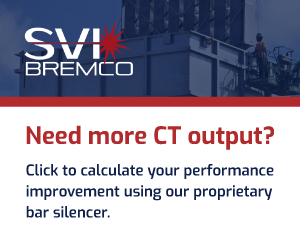During the 7HA Users Group Conference second day, “GE Day,” high-level managers kicked off the event by proclaiming “significant progress in [corporate] restructuring,” HA technology investment is up in 2019, and “we are moving from financial metrics to operating metrics, and users should feel this going forward.”
GE officials shared progress on several issues discussed in the first HA User Conference last year to an attendee group that has swelled by 50%.
As the fleet matures into its fifth year, $2-billion has been invested in the HA technology to date, 96 units had been ordered at the time of the conference (total now stands at 100), 59 have been shipped, 40+ have been commissioned, and 39 are in service—10 more than at the time of last year’s conference—with more than 415,000 hours of commercial operation.
All but one or two HA plants are operating baseload. For seasoned power-industry veterans whose notion of “baseload” may be different, here it is defined as a higher than 40 ratio of factored fired hours (FFH) to factored fired starts (FFS). In a hint of performance to come, GE believes it can push maximum ramp rates from 60 MW/min to 90.
Approximately 80% of the first-stage-bucket (S1B) retrofit outages have been completed. FieldCore, GE’s field service organization, is now 12,000 strong—including 6000 craft, 3000 gas/steam engineers, and 2000 with other skills.
Users questioned executives about the internal measurements GE uses to ensure how well FieldCore team members are performing, and quality of final reports—a topic of discussion during the user-day sessions.
After the intro talks, specialists got down to the business of addressing specific technical issues, covered here largely in the order which they were presented. Keep in mind that, in some cases, the issues mentioned are specific to a certain site or a small group of users, and not fleet-level issues. Users are encouraged to check relevant technical information letters (TILs) and contact their GE reps concerning their units.
Rotors. A TIL was released on rotor-life calculation. Main points on rotor life were that maintenance factors provide a process to account for operational variation and are critical for optimized unit operations. Compressor discharge temperature and high ambient temperatures are the important parameters for FFH, while forced cooling during shutdown impacts FFS. Inlet air chilling has significant benefits in rotor life, the presenter noted.
Owner/operators were urged to “consider what it costs on the rotor side to deliver on ISO grid contractual obligations.” A full rotor inspection is required at published rotor life limits to “address accumulated damage.” TILs describe more than one life-limiting factor.
Referencing the release of the rotor life TIL, one user asked if any defects have been found on the rotors and the response was “none associated with the rotors.” The latest units feature “better materials in the middle of the rotor and different cooling strategies,” although the presenter stressed these improvements have nothing to do with the start-to-start vibration issues (see below). GE clarified this exchange, noting that this TIL was a convenient way to publish rotor maintenance factors, and does not suggest an issue.
Hexavalent chrome. GE issued Product Service Safety Bulletin (PSSB) 20180709A to inform users of potential contamination (yellow residue) that has been discovered on some parts during outages. This issue was not brought up in the user sessions, but owner/operators should “expect to find this material.” It originates in anti-seize compounds and forms as a reaction between calcium and chromium compounds at elevated temperature. The PSSB provides guidelines for EHS practices, including respiratory protocols and the handling and removal of this material.
Combustors. TILs have been issued for combustor hardware. GE reported that two units experienced outages because of failures in fuel delivery pipes. To address fuel-line leaks, users are encouraged to implement the axial fuel staging (AFS) leak-detection algorithm outlined in TIL 2194, and install the new bellows and flow-sleeve modifications. Hot fuel units, defined as 300F or higher, are not affected by this issue.
The outer fuel nozzle pre-orifice leak is considered a low-risk event—that is, it presents no downstream effects. No immediate action is required but users should build in time during a planned outage for weld repairs and plan to ship spare end covers to the GE shop for the weld repair. There is a NOx level impact of less than 1 ppm from this issue, noted the specialist
The RCA was described as “data shifts in combustion signals,” and “loose outer fuel-nozzle pre-orifice plugs allowing more fuel flow than anticipated.” Fuel switching may have caused this problem originally.
One user asked if there was a check to determine whether spare end covers had to be shipped back, and the response was to have the site’s GE rep evaluate them.
The center fuel-nozzle leak in 9HA.01 units can potentially lead to “base burning and damage to combustor and hot-gas-path hardware.” The risk is elevated in early operation. Smaller-diameter Omega seals combined with non-conforming end covers is the source of the issue, and seal changes are the recommended solution.
In 7HAs, minor cracks were discovered at the tips of center fuel nozzles at several sites. GE believes the cracks are benign and will continue to monitor them.
Hot gas path. Oxidation distress at the inner and outer sidewalls of the first-stage nozzle (S1N) seals is considered an unplanned outage risk, and a TIL has been issued to address it. The solution is to install new slotted seals at earliest opportunity and retune the unit to minimize the impact on NOx emissions, which can be as high as 3-6 ppm.
Missing material from S1N trailing-edge distress is caused by flaking in the compressor discharge casing and the cold side of the combustion components. Debris flows downstream and blocks impingement cooling to the trailing edge of the S1N. The RCA is still being worked through but GE recommends increasing borescope inspection scope during outages to include the cold side of combustion components.
Rubbing between the S1B and first-stage shroud (S1S) observed on some shroud segments, the subject of TIL 2141, can be addressed by changing 10 non-step shrouds to step shrouds. Concerns with fourth-stage shrouds for a small subset of specific units can be addressed through a configuration evaluation and validation tests.
Accessories. TILs 2149, 2125, 2144, 2110, and 2077 address accessories and controls.
The width of the exhaust aeroplate spans too far over the exhaust joint, specialists said, allowing excitation to force the leading edge to lift upwards and liberate. Recommendations are included in TIL 2149.
Exhaust leakage, a hot topic in the user portion of the conference, is caused by improper installation of the rope seal and the clamping bar inadequately compressing the rope seal. Fixing it requires two to three days per unit. If elevated temperatures are observed, users can also record axial and radial alignment of the diffuser, and install an insulation barrier to protect the hazardous gas panel and exhaust blower motor. For the 9HA exhaust expansion joint, improvements have been made to the flex-seal design.
Regarding exhaust thermocouples (TC), the hybrid TCs, considered an interim step, mitigate connector head and cable failures (but not other types of failures). The Gen II design, constructed of stainless steel instead of Inconel, includes a radiation shield. Units shipped in the last six months still have the original TCs, GE noted.
Oxidation from the 28 in. point to the tip of the wheel space TC is caused by misapplication of over-sheath material, and the TC is unable to withstand the temperatures to which they are exposed. A new design, based on Inconel 625 material for the over-sheath, is being made available “with significantly less lead time than the exhaust TCs.” Field validation is in progress and a TIL will be released soon.
A final presenter under auxiliaries stressed the importance of inlet air filtration as well as meeting the inlet-filter-house leak-detection specification, GEK 111330.
Control systems. To address reported loss-of-HMI events, GE noted that users were often unaware of redundancy loss when one of three servers becomes “unhealthy.” However, the Mark VIe is still protecting the plant. Users are urged to check vSAN disk space consumption, storage drivers version, and the Dell storage controller; review newly added suggested maintenance schedule and troubleshooting documented in GEH6851 rev B; and perform periodic manual system health checks.
GE indicated it was moving to Dell Wyse 5070 for Windows and away from Dell Wyse 7020 for Linux.
Issues with fieldbus and the digital valve positioners (DVP) were raised by one attendee. GE said it was difficult to troubleshoot Fieldbus and recommended a site’s IT techs undergo training in Houston. In the meantime, GE is working with Woodward to improve troubleshooting.
Train vibrations. Start-to-start vibrations continue to be a focus for GE and its user community. GE specialists have identified a root cause described by the “mass shift/system resonance” effect. Excessive and variable movement may be associated with changing circumferential position of the compressor blades on Stages 4-14, with system level resonances amplifying the effect.
The current “Phase I” corrective action is a redesigned, solid, heavier load coupling, around 10% heavier than the original. One has been installed and is currently being validated, with “positive response noted on bearing vibration,” according to GE.
With this primary root cause completed and corrective action identified, GE specialists are turning their attention to secondary factors driving the vibration issues. Unique thermal transients are induced during cold, warm, and hot starts, turndown, and part load operation. Turbine exhaust casing and supports “exhibit visible contribution to movement.” Analysis is in process to determine if future corrective action could be necessary.
Transient vibration limits have been instituted: alarm at 0.65 in./sec, runback at 1.0 in./sec, and trip at 1.25 in./sec.
GEK 63383 Rev G addresses potential modifications to the foundation to address vibration. This is considered an EPC issue. GE is working with customers on timing for when new couplings will be available for each site. In the meantime, GE continues to address the vibration issue with balance shots. This issue is not preventing customers from operating their units, stressed the OEM.
Punch list items. This year, based on requests from several participants with units currently being installed or commissioned, a GE commissioning expert covered best practices, lessons learned, and a punch list of topics that users should focus on. As most of these are site-specific; fall within the gray area of shared responsibility among user, OEM, and EPC; represent standard “no brainer” items for a successful commissioning; and/or are complaints common to most if not all facilities, they are not listed here.
Capping off the day was a comprehensive tour of GE’s Greenville facility, when users got a first-hand look at a good portion of that $2-billion investment in the HA technology, and take-home bottle openers manufactured with GE’s latest additive (3-D printing) production processes.





